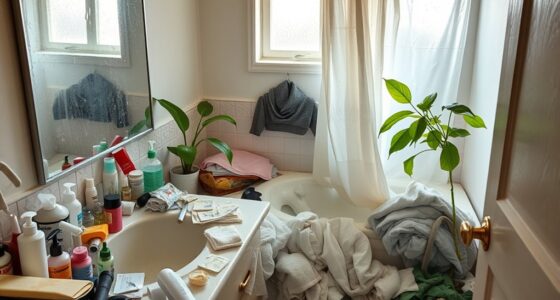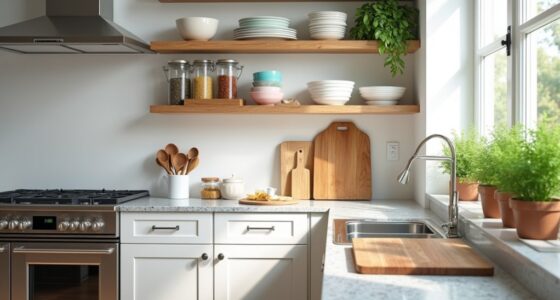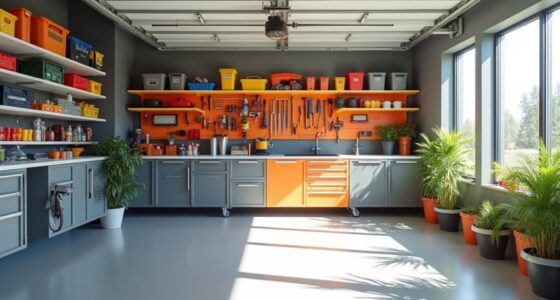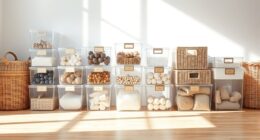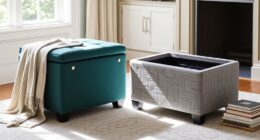To organize your kids' room without tears, embrace a minimalist approach and involve your children in decluttering. Show them how to let go of unnecessary items and create distinct zones for sleeping, playing, and studying. Use smart storage solutions like multifunctional furniture to maximize space. Make organization a fun experience and encourage independence in maintaining tidiness. With a few simple strategies, you can transform the space and reduce stress. Discover more tips to make the process even easier!
Key Takeaways
- Involve your children in the decluttering process to teach them valuable skills and foster ownership of their belongings.
- Create distinct zones in the room for sleeping, playing, and studying to streamline organization and accessibility.
- Use visual aids, like picture labels, to help children understand where items belong and maintain organization easily.
- Implement a regular cleaning schedule and offer praise to reinforce positive organizing habits and make maintenance enjoyable.
- Personalize the space with DIY projects that reflect your child's interests, encouraging pride and comfort in their environment.
Embrace the Less Is More Philosophy

When you embrace the "less is more" philosophy, you'll find that a minimalist approach simplifies your kids' room, making it feel more peaceful and inviting. A clutter-free space promotes calmness and reduces stress, allowing your children to focus on imaginative play. With fewer distractions, they can explore their creativity more freely. Teaching them to maintain an organized environment fosters responsibility and independence, essential life skills for their growth. Regular decluttering and using clear storage solutions help keep the room tidy, supporting minimalist aesthetics. Designating specific zones for play and rest enhances functionality, making it easier for your children to engage in their favorite activities. Ultimately, minimalism transforms their space into a nurturing haven, encouraging both play and relaxation.
Involving Children in the Decluttering Process

Involving children in the decluttering process not only teaches them valuable life skills but also makes the task more enjoyable for everyone.
Start by leading by example; show them how to let go of unnecessary items. Engage in conversations about why decluttering matters and let them participate in decision-making. Establishing a clear purpose for decluttering creates motivation and helps children understand the benefits of having less clutter.
Make it a positive experience—turn it into a fun game to keep their spirits high. Teach them to decide what to keep based on use and love, and encourage ownership of their belongings.
Allowing children to take responsibility fosters pride in their space and reduces stress for the whole family.
Establishing an Effective Organizational System

Creating an effective organizational system for your child's room is essential for fostering independence and maintaining a clutter-free environment.
Start by dividing the room into distinct zones for sleeping, playing, and studying, each with a clear purpose. Place frequently used items within easy reach in their respective zones. Creating zones in the room can significantly enhance the functionality and tidiness of the space. Additionally, a well-organized environment can support emotional regulation, helping children feel more secure and focused.
Simplify the organizational process by breaking tasks into smaller steps and establishing a daily tidying routine. Use visual aids, like picture labels, to guide your child in knowing where items belong.
Work with them to design a system that reflects their needs, utilizing accessible storage solutions. Regularly maintain these zones and be flexible, adjusting them as your child grows and their needs change.
Smart Storage Solutions for Limited Space
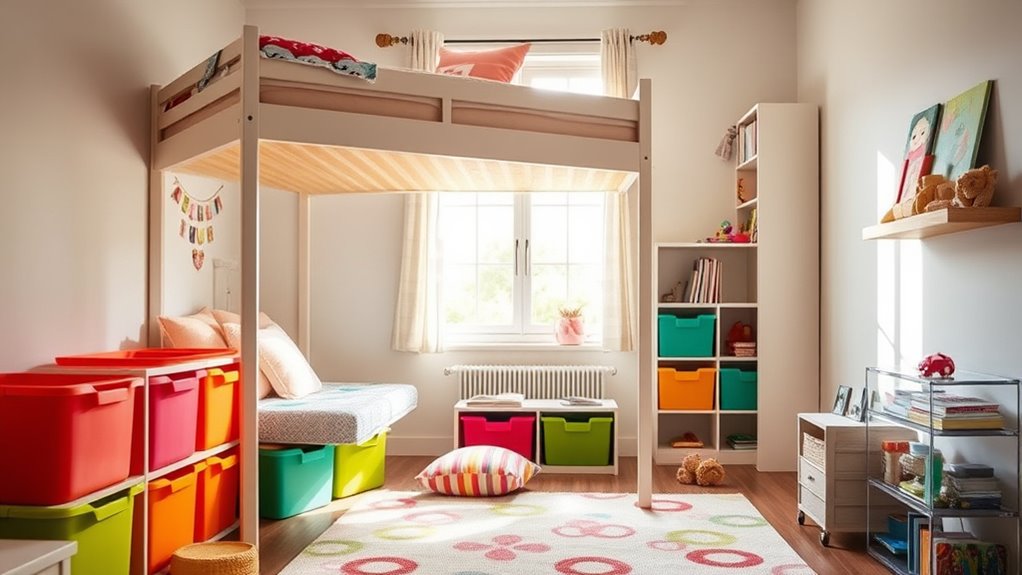
Maintaining an organized kids' room often comes down to smart storage solutions, especially when space is limited. Invest in multifunctional furniture like a desk that doubles as a bedside table or bunk beds to maximize vertical space. Consider loft beds with built-in storage and utilize under-bed bins for clothes and toys. Simple layouts lead to organized and functional rooms, making it easier for children to keep their space tidy. Studies show that organized environments can enhance focus and productivity, which is beneficial for children's development. Install floating shelves and use over-the-door organizers for easy access to frequently used items. Embrace budget-friendly options like milk crates or cube organizers to keep things tidy. Don't forget to optimize vertical areas, such as corner shelves and high storage, to keep the floor clear. With these creative solutions, you'll make the most of every inch and create a functional space for your kids.
Encouraging Independence in Maintaining Organization

When kids feel a sense of ownership over their space, they're more likely to take pride in keeping it organized. Incorporate modular furniture and personalized storage options, like bins and baskets they choose, to foster this independence.
Create distinct zones for activities, which helps contain messes and encourages responsibility. Use accessible furniture, such as low beds and child-sized tables, to promote self-sufficiency. Clear labels on storage make it easier for them to understand where things belong. Additionally, involving them in decisions about what stays or goes can enhance their sense of ownership over their belongings. By modeling organizational skills and offering praise for their efforts, you'll help them develop habits that ensure their room remains a tidy, enjoyable space.
Making Organization an Enjoyable Experience

Making organization enjoyable doesn't have to feel like a chore; in fact, it can be a fun and engaging experience for you and your kids. Involve them in the process to foster ownership of their space. Declutter together, turning it into a game where they learn to let go of unused items. Incorporate colorful storage solutions and personal touches to make the room inviting. Setting up speed clean challenges with timers or organizing tasks as games keeps it lively, and organization promotes a sense of control, making the process more rewarding. Additionally, regular veterinary check-ups can also teach kids about responsibility and care for their pets as they learn to manage their own space. Play music to create a cheerful atmosphere, and consider a reward system for completed tasks.
Strategies for Sustaining an Organized Space

Creating an organized space for your kids is just the beginning; keeping it that way requires a thoughtful approach. Start with regular decluttering, especially during seasonal changes or before holidays. Sort through items together, teaching your kids the importance of letting go of what they no longer need. To further simplify the process, choose bins and baskets without lids for easier access and to encourage organization.
Use containers to group similar items and implement a labeling system so they can easily find where things belong. Establish a cleaning schedule and create zones for different activities to maintain order. Encourage your children to take responsibility for their space, making organizing a fun and engaging task. Finally, offer praise and rewards for their efforts, reinforcing positive habits that keep their room organized over time.
Adapting to Changing Needs Over Time

As your child grows, their needs and interests will change, requiring a flexible approach to room organization. Opt for modular furniture that can evolve with them, like a dresser that doubles as a desk. Choose versatile decor that can be easily updated to reflect their interests, and implement customizable storage solutions to keep up with their changing requirements. Dynamic spaces allow for a variety of activities and interests to be embraced as they develop. Room dividers can help create separate areas for activities as they grow. DIY projects can add personal touches that resonate with their current passions. Remember, incorporating multifunctional elements and adjustable shelving maximizes space while promoting independence. Furthermore, creating an environment that fosters aging in place can encourage your child to adapt their space as they mature. Regularly reassess the room's layout and functionality to ensure it meets your child's developmental stages and preferences.
Frequently Asked Questions
How Do I Get Started With Decluttering My Child's Room?
To get started with decluttering your child's room, set clear goals about what you want to achieve.
Involve your child in the process, so they understand its importance. Schedule a specific time for this task and gather bins for sorting.
Begin by categorizing items, focusing on easy areas first. Create a positive atmosphere to make it fun.
Remember to celebrate small victories along the way, reinforcing the benefits of a tidy space.
What Age Should Children Start Organizing Their Own Space?
You might think your child's room is a chaotic masterpiece, but it's never too early to encourage organizing.
By age 3, kids can start learning basic skills like sorting and categorizing. As they grow, around age 6, they can take on more responsibility, managing their space and routines.
Involving them in the process not only fosters independence but also cultivates lifelong habits that can turn that chaos into a cozy haven.
How Can I Handle Sentimental Items When Decluttering?
When you're decluttering sentimental items, start by gathering everything in one spot.
Review each piece and set boundaries on what to keep. Take photos of items that evoke strong memories but don't need to stay.
Acknowledge your emotions and focus on the memories instead of the objects. Involve a friend for support, and remember to take your time—this process is about preserving what truly matters while letting go of the rest.
What Are Some Tips for Maintaining Organization During Busy Seasons?
During busy seasons, simplify your organizational systems.
Prioritize essential items and declutter before holidays to avoid overflow.
Use temporary storage for seasonal items, keeping your space manageable.
Involve your family in maintaining order, sharing responsibilities to lighten the load.
Establish flexible expectations, allowing for adjustments when life gets hectic.
Remember to set aside time for quick clean-ups, keeping your environment organized without overwhelming anyone.
Stay patient and adapt as needed!
How Can I Motivate My Child to Keep Their Room Tidy?
You'd think motivating your child to keep their room tidy would be as easy as waving a magic wand, right?
Instead, focus on fun! Turn cleaning into a game or play their favorite music while tidying up. Give them choices about storage, so they feel empowered.
Regular feedback and praise can work wonders too. Remember, kids thrive on routine, so establish a cleaning schedule and watch their motivation soar!
Conclusion
By embracing the less-is-more mentality and involving your kids in the clutter-clearing quest, you can create a captivating and cohesive space. With smart storage solutions and systems in place, your children will gain the independence to maintain their rooms. Make organization a fun-filled adventure, and you'll foster a sense of ownership. Remember, as their needs evolve, so should your approach. With these strategies, you'll transform tidying into a treasured routine, nurturing creativity and calm in their space.


